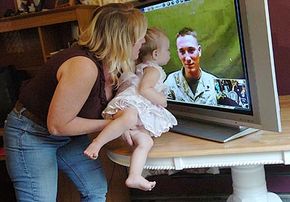Beyond the Military
Military bases don't have a monopoly on video technology used to connect families at home with members deployed to a war zone. Veteran support groups, churches and charities all offer video conferencing to connect families to loved ones. In some parts of the United States, the Red Cross runs "Operation Video Connect," which helps military families record audio and video messages for those deployed overseas. These messages are e-mailed to the troops as attachments or made available for viewing or downloading.
Freedom Calls Foundation is the largest not-for-profit organization working with the military and private industry to offer free video conferencing to families, especially during holidays when the separation can affect morale the most. The foundation has organized video conferencing at football games and graduations -- and even made a military wedding possible for a bride in Iraq and a groom in Colorado. The foundation receives no funding from the military and relies on help from individuals and corporations in monetary donations, equipment, technology and expertise.
Advertisement
Besides maintaining an international satellite network, the foundation has also constructed Freedom Calls communication centers at five military bases in Iraq and Afghanistan. Camp Taji, north of Baghdad, had one of the first, which offers free video teleconferencing and high-speed Internet systems with e-mail and Web-based phone lines. The facility serves 15,000 troops and has 40 computers, four enterprise class video conferencing units and 30 telephones. Camp residents and families sign up for satellite time and can note special events that require video conferencing, such as teacher-parent conferences. Freedom Calls maintains 10,000 sites in the United States where families can go to video conference. The foundation also provides Web cameras and software to enable families to conference from their homes.
Video conferencing technology has become "mission critical" to the U.S. military, according to the Armed Forces Communications and Electronics Association Web site. And while video conferencing isn't as widely available as e-mail to the average soldier, that's changing as technology improves. If past performance is any indication, as wartime use of video conferencing becomes more refined, morale building and readiness uses will also evolve.
For more information about military video conferencing and related topics, check out the links below.
